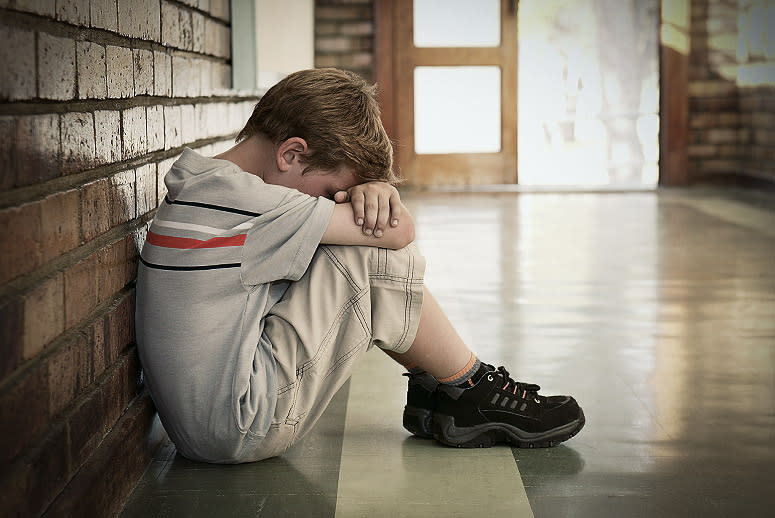School Discipline Policies Force LGBT Kids out of the Classroom

Punished for holding hands with a boyfriend or girlfriend, for wearing non-gender-conforming clothing to class or prom, or for defending themselves against verbal harassment and physical assault—those are just some of the discriminatory incidents LGBT students experience in U.S. public schools. According to a new report from the Gay, Lesbian and Straight Education Network, these unfair school disciplinary policies are pushing LGBT students out of the classroom and into the criminal justice system.
The report, released last week, found that nearly 36 percent of LGBT students had received detention, 15.1 percent of LGBT students had been suspended from school, and 1.3 percent of LGBTQ students had been expelled, often for infractions related to identity or orientation.
RELATED: These Are the Hardest States in America to Be LGBT
Almost 20 percent of LGBT students said they were “prevented from wearing clothing deemed ‘inappropriate’ ” based on their legal sex, and nearly 30 percent “reported that they had been disciplined for public affection that is not similarly disciplined among non-LGBTQ students,” the authors wrote.
As has been found with black students, the punitive discipline and harsh practices that push students out of school and out of the classroom—such as detention, being sent to the principal’s office, or being suspended—put youths in the school-to-prison pipeline. Just over 2 percent of LGBT youths “said they had contact with the juvenile or criminal justice system as a result of disciplinary action at school,” reads the report.
“Most schools do have bullying and harassment policies, but many schools do not have the kind that we know adequately protect LGBTQ youth,” Emily Greytak, GLSEN’s director of research, told TakePart. “Those would be ones that specifically include and enumerate protections in categories that include sexual orientation, gender identity, and expression among race, religion, and disability.”
GLSEN encourages schools to decrease their surveillance and policing approaches, which Greytak said have proliferated over the last two decades in an attempt to ensure school safety.
“What has happened is that [schools] end up criminalizing students and student conduct quite often. School resource officers and metal detectors are often implemented in ways that disproportionately affect LGBTQ youth as well as African American youth, Latino youth, and youth with disabilities,” she said.
RELATED: Suspending Teens Ruins Lives and Costs Taxpayers $35 Billion a Year
Instead, schools should use “more restorative practices that are more about building community and keeping kids in school instead of pushing them out using zero-tolerance policies and things like that,” Greytak said—and those practices need to start at the elementary level.
In elementary schools, the biggest targets for bullying are often kids who may have a gender expression that’s different from what would be assumed based on their sex assigned at birth. “There’s the boy who might like to wear dresses or the girl who’s more interested in playing with trucks and hanging out with the boys,” Greytak said.
Other seemingly innocent practices such as splitting elementary school classes into boys’ and girls’ lines—even when they’re going to the same place—reinforce the idea of boys and girls being separate and different. It can also be confusing to children who aren’t yet sure if they feel like a boy or a girl but don’t want to publicly out themselves.
“Really, it’s making sure that schools understand the damage that these gender stereotypes can do to all students, but particularly the students who may grow up to be LGBTQ, and then making sure that teachers are trained to critique those stereotypes and intervene when they see them and create an environment that is free of those,” Greytak said.
Adding more school counselors and mental health professionals who are trained to support youths, and providing ongoing training to teachers, is essential to keeping LGBT students in the classroom—as are antidiscrimination policies in which school districts enumerate student protections, Greytak said. She said one encouraging change is that more schools are adopting policies related to transgender students that outline the way districts will protect their rights and ensure that they’re treated fairly.
“That goes into allowing transgender students to use the bathrooms and locker rooms that are appropriate for their gender, not necessarily their sex that’s assigned at birth, and allowing them to compete on certain sports teams and use their preferred name and things like that,” she said.
RELATED: Samantha Bee Reveals Hypocrisy in One Lawmaker’s Anti-Trans Bill
Some of that support should come from implementing a curriculum that’s inclusive of the LGBT community, ensuring that LGBT people are incorporated into events and into what’s being taught so that students can see themselves reflected.
“If a student feels like the curriculum isn’t relevant to them, if a student repeatedly does not see themselves reflected in the curriculum, it’s easier for them to disengage,” Greytak said. “We know that when they do have it, and when they have supportive teachers and those who are teaching in a way that’s LGBT inclusive, they’re more likely to feel connected to their school, and that’s going to be one of the predictors of what keeps them in school.”
Take the Pledge: Pledge to Be an Ally of the LGBTQ Community
Related stories on TakePart:
• Gay Men Who Were Attacked With Boiling Water Speak Out About Ordeal
• The Most Sexist and Antigay Places in America, According to Twitter
• NYC Schools Are Latest Battleground in the Fight for Free Tampons
Original article from TakePart

